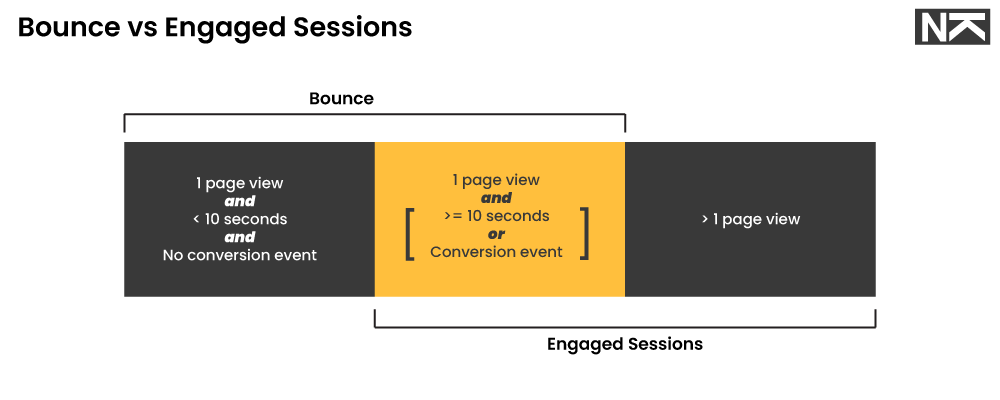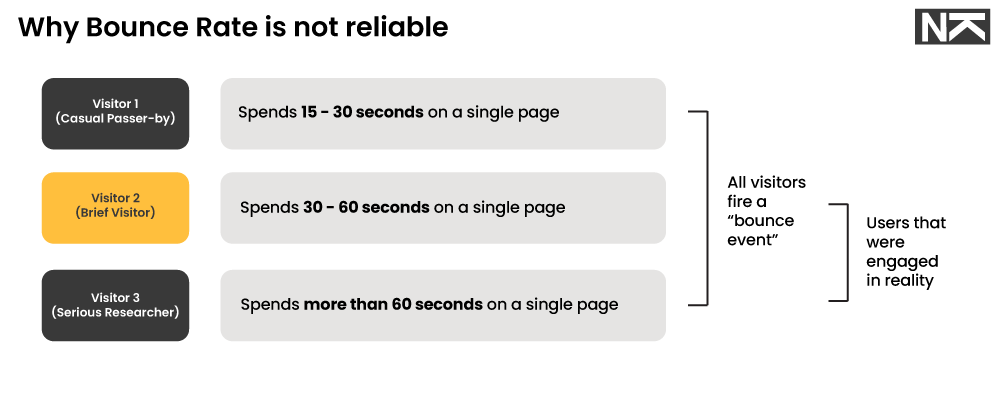Many of us have come to rely on bounce rate as a metric to gauge user behaviour on our website. However, if you’ve shifted to Google Analytics 4 then you must have noticed that it does not report the bounce rate metric anymore. It has been replaced by a new metric called engagement rate.
Let’s first go through the differences between the two:
Bounce Rate vs Engagement Rate
According to Google, a “bounce” refers to a single-page session on your website. Bounce rate is calculated by dividing the single-page sessions (or “bounces”) by the total sessions.
In the legacy version of Google Analytics, i.e. Universal Analytics, analysts used to look at the bounce rate to measure user engagement and behaviour on the website. However, it’s not always the best metric to look at.
Why?
Because it only applies to specific types of websites. If your website’s homepage is a gateway to other more relevant content on your website, then bounce rate is important. As you will want to see how many people are getting encouraged to explore more on your website.
But there are certain types of websites that do not require people to go on other pages (eg. Blogs). Suppose a person searches “how to install google analytics”, clicks on one of the links on the Google Search Results page and lands on a blog post.
The visitor then shuts the tab after reading the blog post. This will trigger a bounce even though the user is satisfied and has received relevant information. That’s why blogs generally have a very high average bounce rate. According to CXL, average bounce rates for blogs can range between 65 – 90%.
In the newer version of Google Analytics (GA4), Google has introduced the engagement rate metric. For a session to classify as engaged, the visitor must have done at least one of the following things:
- Actively engaged with the website page for more than 10 seconds.
- Fire a conversion event.
- Performed 2 or more page views.
The engagement rate is calculated by dividing the number of engaged sessions by the total number of sessions.

Note: You can’t simply calculate engagement rate from bounce rate by doing 100% – bounce rate, as apart from single-page sessions, engagement rate also takes other variables into consideration.
If you want to know how to check engagement rates in Google Analytics 4, you can check out our 6 Important User Behaviour Metrics You Should Track post.
Which is the better Metric?
So if you’re wondering which metric will win if it’s Bounce Rate vs Engagement Rate, then it’s definitely engagement rate.
Let us understand this better with an example.
You have a blog where you write content about drones. You published a blog post “Best drones to buy under $100”, which is now attracting visitors from Google Search. Suppose you get 3 visitors on that blog post.
Visitor 1 (Casual Passer-by): This visitor lands on the blog post, quickly skims through the headlines and leaves the page with 15-30 seconds.
Visitor 2 (Brief Visitor): They are thinking of buying drones sometime in the future and are just starting their research. They go through some of the content and then leave spending somewhere between 30 – 60 seconds on the page.
Visitor 3 (Serious Researcher): This visitor is in the consideration stage and is doing some extensive research as they have to make a purchase decision soon. They go through the blog post thoroughly spending more than 60 seconds and then leave the page.

In the case of all 3 visitors, a “bounce” will be triggered as it was just a single-page session. You can still ignore the 1st visitor (casual passer-by) but bounce rate fails to acknowledge the importance of the remaining two visitors.
The last two visitors actually engaged with the content and were happy with the quality of information they received from the blog post. GA4 will count these users as engaged and will take them into consideration while calculating the engagement rate.
Winner: Engagement Rate
So if you haven’t already, switch to Google Analytics 4 to get a more in-depth and reliable analysis of user behaviour on your website.
Read our latest post for an in-depth comparison of Google Analytics 4 and Universal Analytics.

One Response
Thanks for sharing useful information